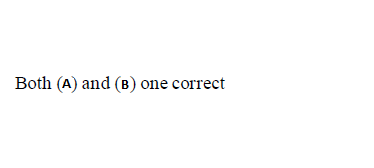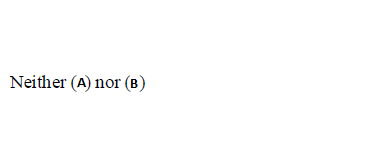131. The cylindrical shape of an alkyne is due to
A
three sigma $$C-C$$ bonds
B
three $$\pi \,C - C$$ bonds
C
two sigma $$C-C$$ and one $$\pi \,C - C$$ bonds
D
one sigma $$C-C$$ and two $$\pi \,C - C$$ bonds
Answer :
one sigma $$C-C$$ and two $$\pi \,C - C$$ bonds
132. The nodal plane in the $$\pi $$ - bond of ethene is located in
A
the molecular plane
B
a plane parallel to the molecular plane
C
a plane perpendicular to the molecular plane which bisects the carbon - carbon $$\sigma $$ - bond at right angle
D
plane perpendicular to the molecular plane which contains the carbon - carbon $$\sigma $$ - bond.
Answer :
the molecular plane
133.
Identify $$X$$ and $$Y$$ in the following reaction.
\[\underset{\begin{smallmatrix}
\,\,\,\,\,\,| \\
\,\,\,\,\,\,\,Br
\end{smallmatrix}}{\mathop{{{H}_{2}}C}}\,-\underset{\begin{smallmatrix}
|\,\,\,\,\,\,\,\, \\
Br\,\,\,\,\,\,
\end{smallmatrix}}{\mathop{C{{H}_{2}}}}\,+KOH\xrightarrow{\text{ alcohol}}\] \[X\xrightarrow{NaN{{H}_{2}}}Y\]
| $$X$$ | $$Y$$ | |
|---|---|---|
| (a) | $$C{H_3}C{H_2}Br$$ | $$C{H_2} = C{H_2}$$ |
| (b) | $$C{H_2}OH - C{H_2}OH$$ | $$C{H_2} = C{H_2}$$ |
| (c) | $$C{H_2} = CHBr$$ | $$CH \equiv CH$$ |
| (d) | $$CH \equiv CBr$$ | $$CH \equiv CH$$ |
A
(a)
B
(b)
C
(c)
D
(d)
Answer :
(c)
134. During halogenation of alkanes the halogens and alkane show a specific trend. Which of the following statements is not correct?
A
The reactivity of halogens is in the order $${F_2} > C{l_2} > B{r_2} > {I_2}.$$
B
For a given halogen the reactivity of hydrocarbon is in the order of $${3^ \circ } > {2^ \circ } > {1^ \circ }.$$
C
Bromine is less reactive than chlorine towards a particular alkane.
D
On chlorination monosubstituted product is formed while on bromination disubstituted products are formed.
Answer :
On chlorination monosubstituted product is formed while on bromination disubstituted products are formed.
135. In Friedel-Craft’s synthesis of toluene, the reactants in addition to anhydrous $$AlC{l_3}$$ are
A
$${C_6}{H_5}Cl + C{H_4}$$
B
$${C_6}{H_5}Cl + C{H_3}Cl$$
C
$${C_6}{H_6} + C{H_4}$$
D
$${C_6}{H_6} + C{H_3}Cl$$
Answer :
$${C_6}{H_6} + C{H_3}Cl$$
136. Which of the following change is correct
A


B


C


D


Answer :


137. In electrophilic aromatic substitution reaction, the nitro group is $$meta$$ directing because it
A
decreases electron density at $$meta$$ position
B
increases electron density at $$meta$$ position
C
increases electron density at $$ortho$$ and $$para$$ positions
D
decreases electron density at $$ortho$$ and $$para$$ positions.
Answer :
decreases electron density at $$ortho$$ and $$para$$ positions.
138.
How many geometrical isomers are possible for the given compound?
$$C{H_3} - CH = CH - CH = CH - {C_2}{H_5}$$
A
Four
B
Three
C
Two
D
Five
Answer :
Four
139.
In the reaction,
\[\begin{align}
& H-C\equiv CH\xrightarrow[\text{(ii)}\,C{{H}_{3}}C{{H}_{2}}Br]{\text{(i)}\,\frac{NaN{{H}_{2}}}{liq.N{{H}_{3}}}} \\
& X\xrightarrow[\text{(ii)}\,C{{H}_{3}}C{{H}_{2}}Br]{\text{(i)}\,\frac{NaN{{H}_{2}}}{liq.N{{H}_{3}}}}Y \\
\end{align}\]
$$X$$ and $$Y$$ are
A
$$X = 2 - butyne;Y = 3 - hexyne$$
B
$$X = 2 - butyne;Y = 2 - hexyne$$
C
$$X = 1 - butyne;Y = 2 - hexyne$$
D
$$X = 1 - butyne;Y = 3 - hexyne$$
Answer :
$$X = 1 - butyne;Y = 3 - hexyne$$
140. Which one of the following will react fastest with $${H_2}$$ under catalytic hydrogenation condition ?
A


B


C


D


Answer :



